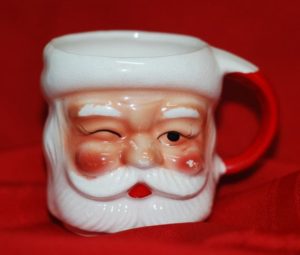 Every year, when the first of January rolls around, I carefully remove two dozen fragile treasures from the top shelf of the bookcase in my kitchen and wrap them each in tissue paper. Then I gently nestle them into a plastic container with a latching red lid. It’s labeled SANTA FACE MUGS.
Every year, when the first of January rolls around, I carefully remove two dozen fragile treasures from the top shelf of the bookcase in my kitchen and wrap them each in tissue paper. Then I gently nestle them into a plastic container with a latching red lid. It’s labeled SANTA FACE MUGS.
Eleven months later, I wonder whether it’s worth it to do it all over again.
So far, the answer is still yes. These are mugs I’ve been casually collecting for a couple of decades. You see them at thrift stores and junk stores and even fine antique stores, especially as Christmas draws nigh. Though I once paid five dollars for a Santa face mug in particularly good condition, most of the mugs in my collection cost only a dollar or two. Several were given to me by a friend who’d grown weary of the wrapping and unwrapping.
Santa-themed tableware got its start more than 70 years ago when brothers Bob and John Howard met Grant Holt while attending college at the University of Massachusetts Amherst. With a 9,000 dollar loan from both sets of parents, the three young entrepreneurs started a holiday ceramic ware company called Holt-Howard in 1949 in New York City. Their products were designed to appeal to young consumers who didn’t want to decorate their homes like their parents had always done. Santa face pitchers and mugs were some of the earliest bestsellers. The company moved its headquarters to Connecticut in 1955 and, in order to lower labor costs, relocated its manufacturing plant to Japan.
There are countless copycat Santa face mugs, of course. Truth be told, I probably have a lot of them in my collection. I searched the bottom of each mug before writing this column and didn’t find even one bearing the prized foil label “HH Japan.” But I did find several mugs that said Japan, one stamped China and one made in Taiwan.
But no matter. I didn’t buy the mugs for their authenticity or monetary value. I bought them and continue to mess with them every Christmas because they make me smile.
No two mugs in my collection are alike, though all have handles on the right side of the mug as you face Santa. None are double-faced, though Holt-Henry did make a mug with Santa on one side and Mrs. Claus on the other. Most of mine are traditional size but I have a handful that would be better suited for espresso than a regular cup of coffee. Three of my mugs are tiny, probably designed to hold toothpicks rather than a beverage. Two are actually napkin rings rather than mugs, but they fit in nicely with the collection.
Some of the mugs are primarily white. I don’t know if that’s because the paint has chipped away over the years or if they were made that way. I have blue-eyed Santas and brown-eyed Santas and one Santa with eyes that look holographic. Some have a winking left eye and others a winking right. Some have both eyes open, others have both eyes closed. Though a few have eyelashes, most don’t.
All my Santas have chubby cheeks, and though a couple of them have a pale complexion (as would befit someone who lives at the North Pole), most are ruddy-skinned. None of my Santas is African-American, which is disappointing but not surprising for giftware made in the 1950s. I did find several newer-model Black Santa mugs for sale online. I’m thinking I should add at least one to my collection, which must mean I don’t intend to give up this Santa face mug decorating tradition any time soon.
Half an hour a year of wrapping and unwrapping is a small price to pay for something that brings so much joy.
(December 15, 2019)